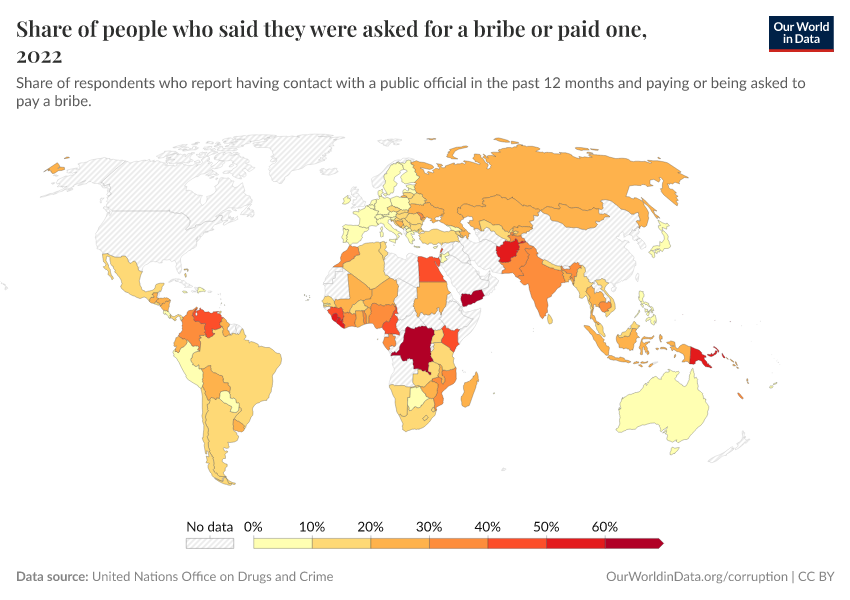Share of people who said they were asked for a bribe or paid one

What you should know about this indicator
- This indicator measures how common bribery is in people’s everyday interactions with public officials. It shows the share of individuals who, in the past year, either paid a bribe or were asked to pay one during contact with a public official.
- Bribes can take the form of money, gifts, or favors given in exchange for special treatment. The focus is on petty or administrative bribery — the kind people may face when accessing basic services, such as dealing with the police, schools, or healthcare.
- “Public officials” refers to anyone holding a legislative, executive, administrative, or judicial role — including police officers, customs agents, judges, teachers, and doctors. The data does not cover high-level political corruption, trading of influence, or abuse of office.
- Data comes primarily from national surveys, where respondents report their own direct experiences. Reports involving intermediaries (e.g. a bribe paid through someone else) are included, but second-hand accounts from other household members are excluded.
- When national data is unavailable or insufficient, estimates may draw on Global Corruption Barometer (GCB) data, provided it aligns closely with UNODC definitions. These estimates are reviewed and validated by national authorities, usually through national statistics offices.
- In some cases — such as Peru and Panama — estimates differ from published GCB figures. These differences may arise from variations in survey scope (e.g. GCB asks about 6–8 specific services, while other surveys ask more generally), sample size, how people without recent contact with officials are handled, or how surveys are conducted (e.g. phone vs. in-person).
- Because bribery often leaves no paper trail, surveys remain one of the most practical ways to measure it. However, earlier surveys often excluded people who were asked for a bribe but refused to pay. This likely led to underestimates. More recent efforts aim to correct this by applying standardised methods across countries.
Related research and writing
Sources and processing
This data is based on the following sources
How we process data at Our World in Data
All data and visualizations on Our World in Data rely on data sourced from one or several original data providers. Preparing this original data involves several processing steps. Depending on the data, this can include standardizing country names and world region definitions, converting units, calculating derived indicators such as per capita measures, as well as adding or adapting metadata such as the name or the description given to an indicator.
At the link below you can find a detailed description of the structure of our data pipeline, including links to all the code used to prepare data across Our World in Data.
Reuse this work
- All data produced by third-party providers and made available by Our World in Data are subject to the license terms from the original providers. Our work would not be possible without the data providers we rely on, so we ask you to always cite them appropriately (see below). This is crucial to allow data providers to continue doing their work, enhancing, maintaining and updating valuable data.
- All data, visualizations, and code produced by Our World in Data are completely open access under the Creative Commons BY license. You have the permission to use, distribute, and reproduce these in any medium, provided the source and authors are credited.
Citations
How to cite this page
To cite this page overall, including any descriptions, FAQs or explanations of the data authored by Our World in Data, please use the following citation:
“Data Page: Share of people who said they were asked for a bribe or paid one”, part of the following publication: Esteban Ortiz-Ospina and Max Roser (2019) - “Corruption”. Data adapted from United Nations Office on Drugs and Crime. Retrieved from https://mdim-pisa.owid.pages.dev:8789/20250704-121343/grapher/bribery-prevalence-un.html [online resource] (archived on July 4, 2025).How to cite this data
In-line citationIf you have limited space (e.g. in data visualizations), you can use this abbreviated in-line citation:
United Nations Office on Drugs and Crime – with minor processing by Our World in DataFull citation
United Nations Office on Drugs and Crime – with minor processing by Our World in Data. “Share of people who said they were asked for a bribe or paid one” [dataset]. United Nations Office on Drugs and Crime, “Data from multiple sources” [original data]. Retrieved July 11, 2025 from https://mdim-pisa.owid.pages.dev:8789/20250704-121343/grapher/bribery-prevalence-un.html (archived on July 4, 2025).